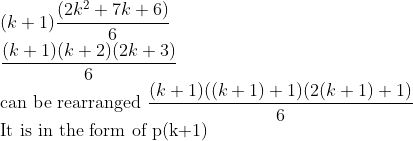Principle Of Mathematical Induction Class 11th Notes - Free NCERT Class 11 Maths Chapter 4 notes - Download PDF
Class 11 Math chapter 4 notes are regarding Trigonometric functions. In chapter 4 we will be going through the Mathematical Induction concepts in Principle of Mathematical Induction Class 11 notes. This Class 11 Maths chapter 4 notes contains the following topics: Mathematical induction principles and a few examples.
This Story also Contains
- NCERT Class 11 Math Chapter 4 Notes
- Significance of NCERT Class 11 Maths Chapter 4 Notes:
- NCERT Class 11 Notes Chapter Wise.
NCERT Class 11 Math chapter 4 notes also contain important formulas. NCERT Class 11 Math chapter 4 contains systematic explanations of topics using examples and exercises. NCERT Notes for Class 11 Math chapter 4 includes FAQ’s or frequently asked questions about the chapter. Every concept that is in CBSE Class 11 Maths chapter 4 notes is explained here in a simple and understanding way that can reach students easily.
All these concepts can be downloaded from Class 11 Maths chapter 4 notes pdf download, Principle of Mathematical Induction Class 11 notes, Class 11 Principle of Mathematical Induction notes pdf download.
Also, students can refer,
NCERT Class 11 Math Chapter 4 Notes
Mathematical Induction:
It is a mechanism, procedure, or technique to prove mathematical equations using a few principles. So as we use principles and solve these equations we call it the principles of mathematical induction.
3 steps to follow to solve using mathematical induction:
Let p(n) be a statement and n be a natural number:
Step 1 : (Basis Step)
L.H.S and R.H.S are equal for n=1 for given statement p(1).
Step 2 : (Introduction Step)
When the statement that is given is true for Assume(n=k), it should also be proved true for n=k+1 where we get LHS=RHS.
Step 3: (Conclusion Step)
Then we can state that proved Principles Of Mathematical Induction.
Let’s see an example:
Using the principles of mathematical induction prove the following statement :

Ans:
Step 1:
Substitute n=1 in the given equation.
LHS= 1
RHS = n(n+1)(2n+1)/6 = 1 (1+1)(2(1)+1)/6 = 1 X 2 X 3/6 = 6/6 =1
Therefore LHS = RHS. Proved
Step 2:
Assume n=k for the given equation
Replace n with k

Now we should prove it to be true for n=k+1
p(k+1)
Add (k+1)² on both sides of the equation


Hence proved from the principle of mathematical induction the given equation p(n) is true for n.
2. Using the principles of mathematical induction prove  is divisible by 4.
is divisible by 4.
Ans:
Step 1:
Substitute n=1 in the given equation.
LHS = 7-3= 4 is divisible by 4.
LHS = RHS
Hence proved.
Step 2:
Assume n=k for the given equation
Replace n with k
 (d is some natural value)
(d is some natural value)
Now we should prove it to be true for n=k+1
p(k+1)
Add (k+1) on both sides of the equation

As it is multiple of 4. So divisible by 4.
p(k+1) is true for p(k) .
Hence proved from the principle of mathematical induction the given equation p(n) is true for n.
With this topic we conclude NCERT class 11 chapter 4 notes.
The link for the NCERT textbook pdf is given below:
URL: ncert.nic.in/textbook/pdf/kemh104.pdf
Significance of NCERT Class 11 Maths Chapter 4 Notes:
NCERT Class 11 Maths chapter 4 notes will be very much helpful for students to score maximum marks in their 11 board exams. In Principle of Mathematical Induction Class 11 chapter 4 notes, we have discussed many topics: Mathematical induction principles and a few examples. NCERT Class 11 Maths chapter 4 is also very useful to cover major topics of the Class 11 CBSE Maths Syllabus.
The CBSE Class 11 Maths chapter 4 will help to understand the formulas, statements, rules in detail. This pdf also contains previous year’s questions and NCERT textbook pdf. The next part contains FAQ’s or frequently asked questions along with topic-wise explanations. These topics can be obtained by the Principle of Mathematical Induction Class 11 chapter 4 pdf download.
NCERT Class 11 Notes Chapter Wise.
NCERT Class 11 Maths Chapter 4 Notes |
Subject Wise NCERT Exemplar Solutions
- NCERT Exemplar Class 11 Solutions
- NCERT Exemplar Class 11 Maths
- NCERT Exemplar Class 11 Physics
- NCERT Exemplar Class 11 Chemistry
- NCERT Exemplar Class 11 Biology
Subject Wise NCERT Solutions
- NCERT Solutions for Class 11 Mathematics
- NCERT Solutions for Class 11 Chemistry
- NCERT Solutions for Class 11 Physics
NCERT Books and Syllabus
Popular Questions
Courses After 12th
Applications for Admissions are open.
As per latest syllabus. Physics formulas, equations, & laws of class 11 & 12th chapters
JEE Main Important Chemistry formulas
Get nowAs per latest syllabus. Chemistry formulas, equations, & laws of class 11 & 12th chapters
JEE Main high scoring chapters and topics
Get nowAs per latest 2024 syllabus. Study 40% syllabus and score upto 100% marks in JEE
JEE Main Important Mathematics Formulas
Get nowAs per latest syllabus. Maths formulas, equations, & theorems of class 11 & 12th chapters
